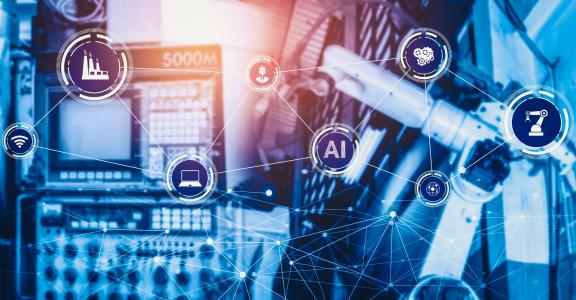
How to use AI for industrial asset forecasting and health management
Sirris's EluciDATA Lab is hosting this event.
For whom?
Engineers, technicians and maintenance personnel responsible for ensuring the reliable and efficient operation of manufacturing equipment and machinery. These techniques can also be relevant for plant managers and executives responsible for making strategic maintenance and asset management.
Why is this relevant to you?
Are you ready to learn about the cutting-edge techniques revolutionizing industrial asset design and maintenance?
1. You want the right insights from your complex set-ups
These assets often operate in complex industrial environments, influenced by various factors such as environmental conditions, other assets in the fleet and interaction with a human end-user (operator).
These assets require sophisticated PHM methods to assess their health, meet the increasing demands for functionality and quality and provide early warnings of potential failures.
-
During the event, we'll give you a broad overview of advanced techniques for PHM
2. You want to stay ahead of the curve
By leveraging PHM, companies can gain valuable insights, achieve greater operational efficiencies, and improve their after-sales services. Don't miss out on this opportunity to stay ahead of the curve in industrial asset design and maintenance!
We will give you:
- Keynote presentations from leading industrial companies
- State-of-the-art research results illustrated with industrial use cases
What will you gain from attending?
During this thematic event, you will:
- learn about the opportunities of PHM in industrial contexts;
- be inspired through real-world use cases;
- have the chance to talk to experts and ask questions;
- be able to discuss with colleagues the challenges related to PHM of industrial assets;
- network with peers.
Program (tentative)
12:00: Lunch
13:00: Welcome
13:30: Setting the context
13:40: Reducing the cost of energy using data - Joris Boeye, ZF Wind Power Antwerpen NV
ZF Wind Power develops digital products and services that increase the availability of connected wind turbines. These solutions build on the market's changing attitude towards data sharing between suppliers, OEMs and wind farm operators. By reducing technical barriers for field data exchange and integrating with a Digital Twin, ZF's domain expertise can be leveraged in various ways: this brings benefits in inventory optimization, to reduce downtime and to increase the energy output for our customers.
14:05: Big data analytics for PV plant operation: Benchmarking components with early prediction of losses and failure - Gofran Chowdhury, 3E
3E will show you some results of the R&D activities carried out in the framework of the multiple EU projects. We will talk about how monitoring data can be used for early prediction of losses from soiling, PV degradation,and transformers. In addition, we will present the preliminary results of component benchmarking based on our SynaptiQ database.
14:30: Coffee Break
14:40: An overview of the current state of the art in Prognostic and Health Management based on several real-world industrial use cases:
- From anomaly scores to discrete predictions - Vincent Vercruyssen, DTAI, KU Leuven
Anomaly detection methods assign a real-valued score to each datapoint in a dataset that correlates with how anomalous the method thinks the datapoint is. These scores need to be transformed into discrete predictions by setting a threshold; if the score is higher than the threshold, the datapoint is an anomaly, otherwise it is normal. The standard way to do this is to set the threshold such that the proportion of scores above it equals the expected proportion of anomalies in the dataset, i.e., the contamination factor. However, in most real-world problems, such as identifying abnormal behaviours in wind turbine data, the contamination factor is unknown. In this talk, I will discuss two technical methods we designed to help estimate the contamination factor. - Exploitation of Transfer Learning techniques for condition monitoring of rotating machinery - Konstantinos Gryllias, LMSD, KU Leuven
State-of-the-art machine learning models remain data-intensive, relying on massive data for model training. However, an extensive training dataset is not always accessible in practice due to the expensive or time consuming data collection and annotation process. The data-deficiency issue may limit the expressive power of the ML models and deteriorate the models’ performance, thus has become one of the weakest spots of ML techniques. Nowadays Transfer Learning techniques (real to real, simulation to real) are proposed as an alternative to accelerate the preparation of a model. Thus in this short talk Transfer Learning approaches will be briefly presented and some applications with focus on monitoring of rotating machinery (at a component level e.g. bearings and at a system level e.g. wind turbines) will be highlighted. - Advanced techniques for automatic tool wear inspection - Robbert Verbeke, Sirris
For many manufacturing companies, the replacement of tools constitutes a significant share of the operating cost. As tools get more worn, the quality of the produced part diminishes. For this reason, tools are typically replaced after a fixed time long before such quality degradation can occur. By automatically monitoring the tool status the replacement time of tools can be optimized without sacrificing the quality of the produced parts.
Much research has been done to estimate the tool wear using sensor data such as vibration or acoustic emission as input to an AI model. While these give promising results, the scope of the data was too narrow, for example using a fixed cutting speed during the operations, limiting its usefulness for industrial implementation so far.
We will present results of a multi-modal analysis performed using data generated under different conditions. The sensor data captured are vibration, acoustic emission, and cutting forces. This is supplemented with a high-resolution image taken automatically after each operation.
15:40: Closing Remarks
15:50: Networking reception
16:30: End
The masterclass will be held in English.
Price
90 EUR (excl. VAT). Thanks to the support of VLAIO, technology companies based in Flanders pay only 30% of the above price (i.e. 27 EUR (excluding VAT)).
General terms
- Invoices will be sent after the event. You can consult our general conditions on our website.
- If you are unable to attend, you can be replaced by a colleague. Please notify us by email to events.admin@sirris.be of the name of your colleague.
- Cancellations must be made by email to events.admin@sirris.be. You can cancel your participation free of charge up to 3 working days before the event. In case of cancellation after this date or non-participance without cancellation, you will be invoiced for the full participation fee.



